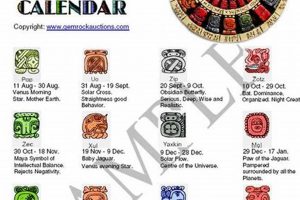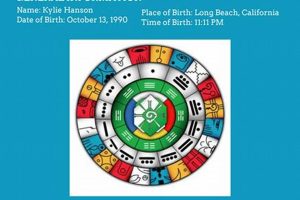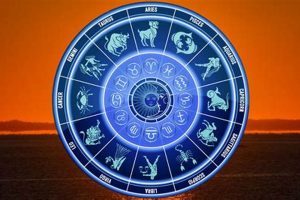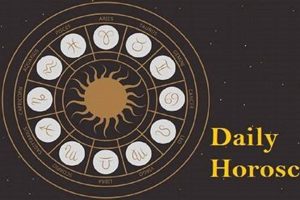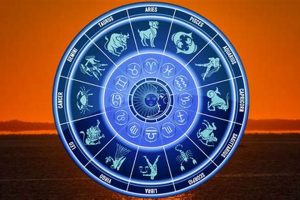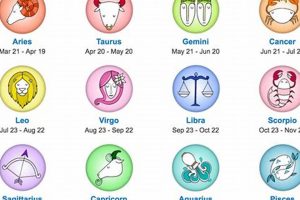A Tzolkin calendar, a 260-day sacred almanac based on the interplay of 13 numbers and 20 day signs, forms the foundation of this Mesoamerican divination system. Each day possesses a unique energetic signature, believed to influence personality, destiny, and favorable or unfavorable periods. Supplemental tools like the Haab, a 365-day solar calendar, and the Long Count, a linear calendar tracking longer periods, provide additional layers of astrological interpretation.
This system offers practitioners insights into their strengths, weaknesses, and karmic patterns. By understanding these influences, individuals can strive for greater self-awareness and navigate life’s challenges with heightened clarity. Rooted in centuries of tradition, this practice provides a framework for understanding the cyclical nature of time and its impact on human experience. This system reflects a sophisticated cosmology developed by a civilization deeply connected to the celestial rhythms.
Further exploration will delve into the intricacies of the Tzolkin calendar, the meanings of the day signs and numbers, and how these elements combine to create a unique energetic profile for each individual. The connection between this ancient system and contemporary astrological interpretations will also be examined.
Tips for Understanding Your Mesoamerican Astrological Profile
These tips offer guidance for navigating the complexities of this ancient system and applying its wisdom to daily life. Understanding one’s unique energetic blueprint can offer valuable insights into personal growth and navigating life’s journey.
Tip 1: Determine Your Day Sign: Identifying your birth date within the Tzolkin calendar reveals your primary day sign, providing insights into inherent personality traits and life path.
Tip 2: Explore the Corresponding Number: Each day sign interacts with a number from 1 to 13, adding another layer of nuance to its interpretation. This number influences the intensity and expression of the day sign’s characteristics.
Tip 3: Consult with a Practitioner: A knowledgeable expert can provide deeper insights into the interplay of energies within a specific profile, offering personalized guidance and interpretation.
Tip 4: Study the Haab and Long Count Calendars: These calendars provide additional context and a broader perspective on individual destinies and larger cycles of time.
Tip 5: Incorporate Rituals and Practices: Engaging in ceremonies and practices aligned with one’s day sign can enhance its positive influences and foster a deeper connection to this ancient tradition.
Tip 6: Reflect on the Daily Energies: Paying attention to the shifting energies of each day within the Tzolkin calendar can inform decision-making and facilitate a more harmonious flow with natural rhythms.
By understanding and integrating these principles, individuals can gain valuable self-knowledge and navigate life with greater awareness. These ancient teachings offer a powerful framework for personal growth and understanding one’s place within the cosmos.
This exploration has offered practical guidance for engaging with this system. Concluding remarks will offer a broader perspective on the enduring relevance of this ancient wisdom.
1. Tzolkin Calendar
The Tzolkin calendar serves as the foundation of a Mayan astrology chart. This sacred 260-day calendar, composed of 13 numbers and 20 day signs, generates a unique energetic signature for each day. Understanding the Tzolkin is crucial for interpreting these charts, as it provides the framework for determining an individual’s primary day sign and its associated influences. For example, a person born on a day marked by the day sign Kan, associated with the seed and germination, might be considered to possess innate creative potential. The accompanying number further refines this interpretation; a Kan 1 might indicate a pioneering spirit, while a Kan 4 could suggest a focus on stability and grounded growth. Without the Tzolkin, the complex interplay of energies within a Mayan astrology chart remains inaccessible.
The Tzolkin’s influence extends beyond individual readings. Its cyclical nature informs broader societal interpretations, providing insights into auspicious periods for various endeavors. Historically, agricultural cycles, ceremonies, and even warfare were planned in accordance with the Tzolkin’s rhythms. This illustrates the practical significance of understanding the calendar not only for personal insight but also for its historical and cultural relevance. The Tzolkin provides a lens through which the Mayan worldview, deeply intertwined with the cyclical nature of time and cosmos, can be understood.
In summary, the Tzolkin calendar is indispensable to interpreting Mayan astrology charts. It provides the fundamental structure through which individual destinies and broader societal patterns are understood. Recognizing the Tzolkins influence clarifies the significance of Mayan astrology as a complex system reflecting a profound connection to time and the cosmos. Further study of the Tzolkin’s intricacies unlocks a deeper understanding of this ancient system and its continued relevance.
2. Haab Calendar
The Haab calendar, a 365-day solar calendar, plays a significant role within the broader context of Mayan astrology. While the Tzolkin calendar focuses on energetic influences and personal characteristics, the Haab grounds these interpretations within the cycle of the solar year, providing a seasonal context for understanding individual destinies. The interplay between these two calendars offers a more comprehensive astrological perspective.
- Seasonal Significance
The Haab is divided into 18 months of 20 days each, plus a five-day period known as Wayeb’. Each month corresponds to a particular season and agricultural cycle, offering insights into auspicious periods for planting, harvesting, and other activities. This connection to the natural world provides a practical dimension to Mayan astrology, rooting its interpretations in the tangible rhythms of the earth.
- Interplay with the Tzolkin
The Haab and Tzolkin calendars operate concurrently, creating a 52-year Calendar Round. This cycle represents the time it takes for the same combination of Tzolkin day and Haab day to recur. This interplay adds another layer of complexity to Mayan astrological interpretations, providing a longer-term perspective on individual and collective destinies.
- Influence on Rituals and Ceremonies
Specific Haab periods held particular significance for rituals and ceremonies. For example, certain months were associated with specific deities or agricultural events, influencing the timing and nature of these practices. This demonstrates the Haab’s integration into daily life, reflecting its importance in shaping cultural and spiritual practices.
- Long Count Correlation
While not directly part of the Haab, the Long Count, a linear calendar tracking longer periods, provides a historical framework within which the Haab and Tzolkin operate. This allows for the placement of specific dates within a broader historical context, enabling astrologers to examine cyclical patterns across generations.
In conclusion, the Haab calendar’s significance in Mayan astrology stems from its connection to the solar year and its interplay with the Tzolkin. By providing a seasonal and cyclical framework, the Haab enhances the depth and complexity of astrological interpretations, grounding them in the observable rhythms of nature and the passage of time. This interwoven system reflects a sophisticated understanding of the cosmos and its influence on human affairs.
3. Long Count Calendar
The Long Count calendar, a system for tracking long periods, provides a crucial chronological framework for understanding Mayan astrology charts. While not directly used for daily divination like the Tzolkin and Haab calendars, the Long Count situates these cyclical calendars within a larger historical context. It allows astrologers to understand the placement of specific events, including births, within broader historical cycles, influencing interpretations of individual destinies and collective societal trends. For instance, a birth occurring during a specific baktun (a 144,000-day period within the Long Count) might be interpreted as carrying the energetic imprint of that period’s historical influences, adding another layer of meaning to the individual’s Tzolkin and Haab designations. The Long Count’s linear nature complements the cyclical nature of the other calendars, offering a more complete picture of time’s influence.
The Long Count’s importance lies in its ability to track vast stretches of time, enabling the correlation of astrological interpretations with historical and archaeological records. This facilitates a deeper understanding of how specific periods within Mayan history, marked by particular events or societal shifts, might have influenced the astrological interpretations associated with individuals born during those times. For example, births occurring during periods of significant political upheaval might be interpreted differently from those occurring during times of peace and prosperity, based on the Long Count’s placement of these periods. This connection between historical context and astrological interpretation allows for a richer, more nuanced understanding of individual destinies and collective narratives.
In summary, the Long Count calendar, while not a primary tool for daily divination, provides an essential historical framework for interpreting Mayan astrology charts. By placing individual birth dates and events within the context of larger historical cycles, the Long Count adds depth and nuance to astrological interpretations, connecting individual destinies to broader societal and historical narratives. Understanding the Long Count’s function enhances appreciation for the sophistication and complexity of Mayan timekeeping and its integration into astrological practice. This integration underscores the Mayan worldview’s intricate understanding of the interconnectedness of time, history, and individual lives.
4. Day Signs (glyphs)
Day signs, represented by unique glyphs, form the core symbolic language of Mayan astrology charts. These glyphs, each imbued with specific meanings and associations, function as archetypal energies influencing personality traits, life paths, and auspicious or inauspicious periods. Understanding the symbolism of these day signs is crucial for interpreting the complexities of a Mayan astrology chart.
- Archetypal Energies
Each day sign embodies a distinct archetypal energy. Imix, for example, represents primordial waters and the beginning of creation, suggesting themes of potential and birthing new ventures. Chicchan, associated with the serpent, symbolizes life force, instinct, and primal energy. These archetypal energies inform the individual’s character and potential life path as indicated within their chart.
- Influence on Personality
Day signs significantly influence personality traits. Individuals born under the sign of Oc, associated with the dog, might exhibit loyalty, companionship, and a strong sense of justice. Those born under Men, associated with the eagle, might demonstrate keen insight, intellectual prowess, and a tendency towards leadership. These traits, while not deterministic, offer insights into inherent predispositions.
- Interaction with Numbers
The meaning of a day sign is further nuanced by its accompanying number, from 1 to 13. This interaction creates a specific energetic signature for each day within the Tzolkin calendar. For instance, a Cauac 4, with Cauac associated with storm and transformation, might suggest a period of upheaval and change leading to growth, while a Cauac 10 could signify a more intense, potentially challenging transformation. The number modifies the day sign’s core meaning, providing a deeper layer of interpretation.
- Interwoven Symbolism
The symbolism of day signs is interwoven with Mayan cosmology and mythology. Many glyphs depict animals, natural elements, or deities, reflecting the Mayan worldview’s interconnectedness with the natural world and the divine. Understanding these symbolic connections provides a richer context for interpreting the day signs’ influence within a chart. For example, the association of Ahau with the sun god Kinich Ahau emphasizes themes of leadership, enlightenment, and divine connection.
In conclusion, day signs serve as the fundamental building blocks of Mayan astrology charts. Their archetypal energies, influence on personality, interaction with numbers, and interwoven symbolism provide a rich tapestry of meaning. Interpreting these glyphs unlocks a deeper understanding of individual destinies and the cyclical patterns influencing human experience within the Mayan astrological system. This intricate system reveals a profound understanding of the interconnectedness of time, individual characteristics, and the cosmos.
5. Numbers (1-13)
Numbers 1 through 13 hold a crucial role within Mayan astrology charts, interacting with the 20 day signs to create the 260-day Tzolkin calendar. These numbers are not merely sequential; they represent distinct energetic influences that modify the characteristics of each day sign. This interaction creates a complex interplay of energies, providing a nuanced understanding of individual destinies and cyclical influences. The number associated with a day sign influences the intensity and expression of its inherent qualities. For instance, the day sign Imix, representing primordial beginnings, combined with the number 1 amplifies the energy of new beginnings and initiative, while Imix combined with the number 7 emphasizes introspection and spiritual connection. The number acts as a lens through which the day sign’s energy is focused, shaping its manifestation in an individual’s life. Therefore, understanding the significance of these numbers is essential for accurate interpretation of a Mayan astrology chart.
Each number carries symbolic weight derived from Mayan cosmology. The number 1 represents unity and new beginnings, while 7 signifies introspection and spiritual connection. 13, the highest number in this cycle, signifies transformation and completion. These numerical energies interact with the day sign energies to create a unique energetic signature for each day within the Tzolkin calendar. Consider the day sign Kan, associated with the seed and growth. Kan 1 might suggest the initiation of a new project or the birth of a new idea, while Kan 13 might indicate the culmination of a growth cycle, requiring reflection and integration of lessons learned. By understanding these numerical influences, individuals gain insights into the cyclical nature of their lives and the specific energies shaping particular periods. This understanding allows for more informed decision-making aligned with these energetic currents.
In summary, the numbers 1 through 13 are integral components of Mayan astrology charts, shaping the expression of day sign energies and influencing the interpretation of individual destinies. Their symbolic weight, derived from Mayan cosmology, adds a layer of complexity to the Tzolkin calendar and its use in astrological divination. Recognizing the influence of these numbers provides a deeper understanding of the cyclical nature of time and its impact on individual lives, offering a framework for navigating life’s journey with greater awareness and alignment with these subtle yet potent energetic forces.
6. Energetic Influences
Energetic influences form the core principle underlying Mayan astrology charts. These influences arise from the complex interplay of the Tzolkin calendar’s day signs and numbers, the Haab calendar’s seasonal cycles, and the Long Count’s historical placement. Each element contributes to a unique energetic signature characterizing an individual’s birth date and influencing their personality, life path, and potential experiences. This concept differs significantly from Western astrology, which primarily focuses on planetary influences. Mayan astrology emphasizes the intrinsic energies associated with specific time periods, viewing time as a cyclical flow of distinct forces impacting human affairs. For example, a person born on a day marked by the day sign Ik, associated with wind and breath, combined with the number 7, signifying introspection, might be considered to possess an innate capacity for deep thought and spiritual exploration. This combination creates a specific energetic influence predisposing the individual towards certain characteristics and experiences.
The practical significance of understanding these energetic influences lies in the potential for self-awareness and informed decision-making. By recognizing the energies associated with their birth date and the current Tzolkin day, individuals can gain insights into their strengths, weaknesses, and potential challenges. This awareness can inform choices regarding career paths, relationships, and personal development. For instance, if a person’s Mayan astrology chart indicates a predisposition towards artistic expression, pursuing a career in the arts might align more harmoniously with their inherent energetic influences. Similarly, understanding the energetic influences associated with specific days can inform the timing of important decisions or actions. A day marked by the energy of Kan, associated with growth and germination, might be considered auspicious for starting new projects, while a day marked by the energy of Cauac, associated with storm and transformation, might be better suited for introspection and inner work. This application of Mayan astrology provides a framework for navigating life’s journey with greater awareness and intentionality.
In summary, energetic influences serve as the foundation of Mayan astrology charts, shaping individual destinies and informing potential life paths. Recognizing the interplay of these energies, derived from the Tzolkin, Haab, and Long Count calendars, offers valuable insights into personal characteristics and cyclical patterns influencing human experience. Applying this understanding to daily life can empower individuals to make more informed decisions aligned with their inherent energetic predispositions and the prevailing energies of specific time periods. This approach to self-discovery and decision-making underscores the enduring relevance of Mayan astrology as a system for understanding the intricate relationship between time, energy, and human experience.
7. Personal Interpretations
Personal interpretations constitute the ultimate objective of engaging with a Mayan astrology chart. While the calendar systems, day signs, and numbers provide the structural framework, personal interpretations translate these elements into meaningful insights applicable to individual lives. This process involves synthesizing the various components of the chart to understand their combined influence on personality, life path, and potential experiences. The depth and accuracy of these interpretations often depend on the expertise and intuitive understanding of the practitioner or individual conducting the analysis. It is within personal interpretations that the abstract principles of Mayan astrology become relevant and actionable for self-discovery and personal growth.
- Synthesis of Chart Components
Personal interpretations involve synthesizing the information derived from the Tzolkin, Haab, and Long Count calendars. For example, an individual’s Tzolkin day sign might indicate a predisposition towards artistic expression, while their Haab birth month might suggest a connection to specific agricultural cycles or seasonal energies. Combining these elements provides a more nuanced understanding of how these influences interact to shape the individual’s creative potential. The Long Count placement can further contextualize these influences within broader historical cycles.
- Understanding Energetic Predispositions
Interpretations aim to reveal an individual’s energetic predispositions. By understanding the energies associated with their day sign, number, and Haab month, individuals can gain insights into their strengths, weaknesses, and potential challenges. For instance, a person born under the day sign Oc, associated with loyalty and companionship, might find fulfillment in careers involving social work or animal care. Recognizing these predispositions can guide individuals towards pursuits aligned with their inherent energetic tendencies.
- Guidance for Life Decisions
Mayan astrology charts can offer guidance for navigating life decisions. By understanding the energies influencing specific periods, individuals can make more informed choices regarding career, relationships, and personal development. If a person’s chart indicates a period of transformation associated with the day sign Cauac, they might choose to approach this time with introspection and a willingness to embrace change, rather than resisting it. This proactive approach allows individuals to work with, rather than against, the prevailing energetic currents.
- Facilitating Self-Awareness
Ultimately, personal interpretations of Mayan astrology charts facilitate self-awareness. By understanding their energetic blueprint, individuals gain insights into their motivations, behavioral patterns, and potential for growth. This self-knowledge can empower individuals to make conscious choices aligned with their authentic selves and navigate life’s challenges with greater clarity and purpose. This ongoing process of self-discovery contributes to a deeper understanding of one’s place within the cosmos and the interconnectedness of all things.
In conclusion, personal interpretations transform the abstract elements of Mayan astrology charts into practical tools for self-discovery and personal growth. By synthesizing the information contained within these charts, individuals gain valuable insights into their energetic predispositions, potential life paths, and opportunities for growth. This process allows individuals to connect with the wisdom of this ancient system in a meaningful and empowering way, using it as a guide for navigating life’s journey with greater awareness and intentionality. This connection highlights the enduring relevance of Mayan astrology as a system for understanding the intricate relationship between time, energy, and human experience.
Frequently Asked Questions
This section addresses common inquiries regarding this Mesoamerican system, providing clarity and dispelling misconceptions.
Question 1: How does this system differ from Western astrology?
This Mesoamerican system emphasizes the energies of specific dates within the Tzolkin and Haab calendars, rather than planetary positions as in Western astrology. It focuses on cyclical patterns and the energetic influences associated with specific time periods.
Question 2: What is the significance of the Tzolkin calendar?
The Tzolkin, a 260-day sacred calendar, is the foundation of this system. Each day possesses a unique energetic signature derived from the combination of a day sign and a number, influencing personality and destiny.
Question 3: How is the Haab calendar used in conjunction with the Tzolkin?
The Haab, a 365-day solar calendar, provides a seasonal context for the Tzolkin’s energetic influences. The interplay of these two calendars creates the 52-year Calendar Round, a significant cycle in this tradition.
Question 4: What role does the Long Count calendar play?
The Long Count is a linear calendar used to track longer periods. It provides a historical context for events and birth dates, enriching interpretations derived from the Tzolkin and Haab calendars.
Question 5: How can one determine their day sign and its meaning?
One’s day sign is determined by their birth date within the Tzolkin calendar. Resources such as online calculators or consultations with practitioners specializing in this system can assist in this process and provide interpretations of the day sign’s meaning.
Question 6: How can this system benefit individuals today?
This practice offers a framework for self-discovery and understanding one’s energetic predispositions. It can provide insights into strengths, weaknesses, and potential life paths, facilitating greater self-awareness and informed decision-making.
Understanding the core components of this systemthe Tzolkin, Haab, and Long Count calendars, and their associated energetic influencesis crucial for accurate and meaningful interpretations.
Further exploration of specific day signs, numbers, and their combined influences will provide a deeper understanding of this ancient tradition and its contemporary relevance.
Mayan Astrology Chart
Exploration of the Mayan astrology chart reveals a complex system rooted in the cyclical nature of time and the interplay of energies. The Tzolkin, Haab, and Long Count calendars, each with unique functions, combine to provide a comprehensive framework for understanding individual destinies and broader societal patterns. Day signs, imbued with symbolic meaning, interact with numbers representing energetic influences, creating a rich tapestry of interpretations. Understanding these components allows for a nuanced appreciation of the system’s depth and its potential for self-discovery.
This ancient system, far from being a relic of the past, offers valuable insights for contemporary life. By understanding the energetic influences shaping individual predispositions and cyclical patterns, individuals can gain greater self-awareness and navigate life’s journey with intention. Further research and exploration of this intricate system promise a deeper understanding of the Mayan worldview and its enduring relevance for understanding the human experience.


